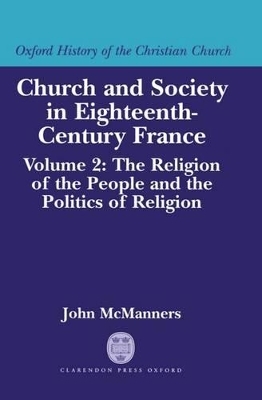
Church and Society in Eighteenth-Century France: Volume 2: The Religion of the People and the Politics of Religion
Seiten
1998
Oxford University Press (Verlag)
978-0-19-826963-2 (ISBN)
Oxford University Press (Verlag)
978-0-19-826963-2 (ISBN)
A reconstruction of the complex hierarchical world of the Gallican Church, destroyed by the French Revolution. This volume explores all aspects of the relations of Church and State including the wealth of the clergy, their role in official life, in the Court at Versailles and on the scaffold.
This second volume begins with a Section on the religion of the people. The clergy offered the liturgical services, sermons, evangelistic missions, and the offices sanctifying birth, marriage, and death; distinctions are made between what they intended and how their ministrations were popularly interpreted and incorporated into the social order. Statistical soundings concerning the extent of religious practice and the degree of conviction involved are evaluated. Further chapters deal with processions, pilgrimages, and popular practices and superstitions, with hermits and confraternities, with the impact of reading the Bible and other edifying literature in an age of increasing literacy. Finally comes a view of the twilight world of magic and sorcery. Throughout this Section the comments of theologians and thinkers of the Enlightenment are recorded, whether in coincidence or contradiction.
The next section deals with the efficacy of the confessional and the role of the casuistry of the Church in attempting to mould sexual mores, business practices, and in the world of the theatre.
In the next two Sections, the role of religious issues in political affairs is detailed. An overview of the Jansenist quarrel and of the activities of the Jesuits brings in the story of the struggle between Crown and Parlement, while an extended portrayal of the life of the Protestant and Jewish communities leads to the history of the debate on toleration, involving the Gallican Church in political interventions and controversy.
Throughout the two volumes the rising forces of anticlericalism and the tensions within the ecclesiastical establishment have been recorded, and these themes come to their climax in a final section on the role played by churchmen in the coming of the Revolution.
This second volume begins with a Section on the religion of the people. The clergy offered the liturgical services, sermons, evangelistic missions, and the offices sanctifying birth, marriage, and death; distinctions are made between what they intended and how their ministrations were popularly interpreted and incorporated into the social order. Statistical soundings concerning the extent of religious practice and the degree of conviction involved are evaluated. Further chapters deal with processions, pilgrimages, and popular practices and superstitions, with hermits and confraternities, with the impact of reading the Bible and other edifying literature in an age of increasing literacy. Finally comes a view of the twilight world of magic and sorcery. Throughout this Section the comments of theologians and thinkers of the Enlightenment are recorded, whether in coincidence or contradiction.
The next section deals with the efficacy of the confessional and the role of the casuistry of the Church in attempting to mould sexual mores, business practices, and in the world of the theatre.
In the next two Sections, the role of religious issues in political affairs is detailed. An overview of the Jansenist quarrel and of the activities of the Jesuits brings in the story of the struggle between Crown and Parlement, while an extended portrayal of the life of the Protestant and Jewish communities leads to the history of the debate on toleration, involving the Gallican Church in political interventions and controversy.
Throughout the two volumes the rising forces of anticlericalism and the tensions within the ecclesiastical establishment have been recorded, and these themes come to their climax in a final section on the role played by churchmen in the coming of the Revolution.
Very big author. This is his magnum opus, the culmination of 40 years work.
| Erscheint lt. Verlag | 27.8.1998 |
|---|---|
| Reihe/Serie | Church and Society in Eighteenth-Century France |
| Verlagsort | Oxford |
| Sprache | englisch |
| Maße | 162 x 243 mm |
| Gewicht | 1415 g |
| Themenwelt | Geschichte ► Allgemeine Geschichte ► Neuzeit (bis 1918) |
| Geisteswissenschaften ► Geschichte ► Regional- / Ländergeschichte | |
| Geschichte ► Teilgebiete der Geschichte ► Kulturgeschichte | |
| Geschichte ► Teilgebiete der Geschichte ► Sozialgeschichte | |
| Geisteswissenschaften ► Religion / Theologie ► Christentum | |
| Sozialwissenschaften ► Politik / Verwaltung | |
| ISBN-10 | 0-19-826963-3 / 0198269633 |
| ISBN-13 | 978-0-19-826963-2 / 9780198269632 |
| Zustand | Neuware |
| Haben Sie eine Frage zum Produkt? |
Mehr entdecken
aus dem Bereich
aus dem Bereich
Europa 1848/49 und der Kampf für eine neue Welt
Buch | Hardcover (2023)
DVA (Verlag)
48,00 €
Giordano Bruno - ein ketzerisches Leben
Buch | Hardcover (2024)
C.H.Beck (Verlag)
29,90 €


